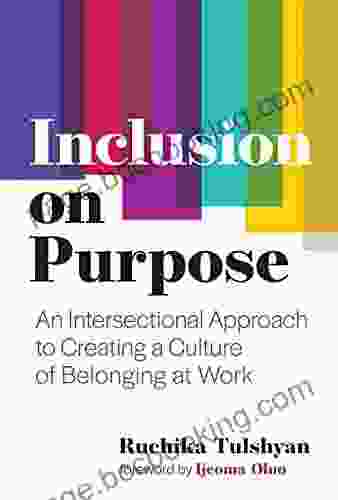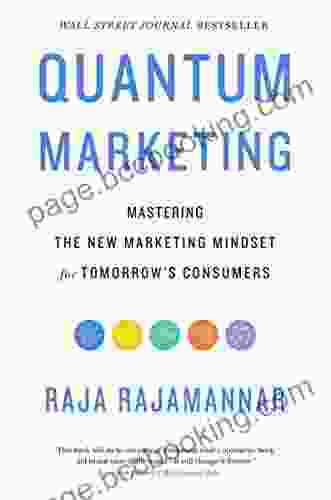An Intersectional Approach to Creating a Culture of Belonging at Work

Empowering Employees to Thrive in a Diverse and Inclusive Environment
In today's rapidly changing and increasingly diverse workplace, creating a culture of belonging is no longer a luxury but a necessity. When employees feel like they belong, they are more engaged, productive, and creative. They are also more likely to stay with their organization and recommend it to others.
4.9 out of 5
| Language | : | English |
| File size | : | 1735 KB |
| Text-to-Speech | : | Enabled |
| Screen Reader | : | Supported |
| Enhanced typesetting | : | Enabled |
| Word Wise | : | Enabled |
| Print length | : | 278 pages |
However, creating a culture of belonging is not always easy. It requires a conscious and concerted effort from all levels of the organization. It also requires a deep understanding of the unique needs and experiences of employees from different backgrounds.
This guidebook provides an actionable framework for creating a workplace where everyone feels valued, respected, and connected. It draws on the latest research on intersectionality, diversity, and inclusion to offer practical strategies for:
- Creating a welcoming and inclusive environment
- Fostering open communication and dialogue
- Addressing unconscious bias and discrimination
- Empowering employees to be allies
- Measuring and evaluating progress
This guidebook is essential reading for anyone who wants to create a more diverse and inclusive workplace. It is a valuable resource for HR professionals, leaders, and anyone who is passionate about creating a culture where everyone can thrive.
Benefits of Creating a Culture of Belonging
There are many benefits to creating a culture of belonging at work. Some of the most notable benefits include:
- Increased employee engagement
- Improved productivity
- Increased creativity
- Reduced turnover
- Improved customer service
- Enhanced reputation
When employees feel like they belong, they are more likely to be engaged in their work. They are more likely to go the extra mile and take initiative. They are also more likely to be productive and creative.
A culture of belonging can also lead to reduced turnover. When employees feel valued and respected, they are less likely to leave their organization. This can save the organization time and money.
In addition, a culture of belonging can lead to improved customer service. When employees feel like they are part of a team, they are more likely to be helpful and responsive to customers.
Finally, a culture of belonging can enhance an organization's reputation. When customers and clients see that an organization is committed to diversity and inclusion, they are more likely to do business with that organization.
Challenges to Creating a Culture of Belonging
There are also some challenges to creating a culture of belonging at work. Some of the most common challenges include:
- Unconscious bias
- Discrimination
- Lack of representation
- Communication barriers
- Resistance to change
Unconscious bias is a type of bias that is often unintentional and unrecognized. It can affect our thoughts, feelings, and behaviors towards people from different backgrounds.
Discrimination is the unfair treatment of a person or group based on their race, gender, religion, sexual orientation, or other characteristics.
Lack of representation can make it difficult for employees from different backgrounds to feel like they belong.
Communication barriers can also make it difficult to create a culture of belonging. Language barriers, cultural differences, and generational gaps can all make it difficult for employees to communicate effectively.
Finally, resistance to change can be a challenge to creating a culture of belonging. Some employees may be resistant to change because they are afraid of the unknown or because they believe that their own culture is superior to others.
How to Create a Culture of Belonging
Creating a culture of belonging is not easy, but it is essential for any organization that wants to succeed in today's diverse and global economy. By following the steps outlined in this guidebook, you can create a workplace where everyone feels valued
4.9 out of 5
| Language | : | English |
| File size | : | 1735 KB |
| Text-to-Speech | : | Enabled |
| Screen Reader | : | Supported |
| Enhanced typesetting | : | Enabled |
| Word Wise | : | Enabled |
| Print length | : | 278 pages |
Do you want to contribute by writing guest posts on this blog?
Please contact us and send us a resume of previous articles that you have written.
 Book
Book Novel
Novel Page
Page Chapter
Chapter Text
Text Story
Story Genre
Genre Reader
Reader Library
Library Paperback
Paperback E-book
E-book Magazine
Magazine Newspaper
Newspaper Paragraph
Paragraph Sentence
Sentence Bookmark
Bookmark Shelf
Shelf Glossary
Glossary Bibliography
Bibliography Foreword
Foreword Preface
Preface Synopsis
Synopsis Annotation
Annotation Footnote
Footnote Manuscript
Manuscript Scroll
Scroll Codex
Codex Tome
Tome Bestseller
Bestseller Classics
Classics Library card
Library card Narrative
Narrative Biography
Biography Autobiography
Autobiography Memoir
Memoir Reference
Reference Encyclopedia
Encyclopedia Mark Lutz
Mark Lutz Sandra Willbanks
Sandra Willbanks Radim Malinic
Radim Malinic Paul J Zak
Paul J Zak Norman L Keltner
Norman L Keltner Nicole Lynn
Nicole Lynn Poppy Green
Poppy Green Rosalyn Sheehy
Rosalyn Sheehy Peter Avery
Peter Avery Roz Goldfarb
Roz Goldfarb Preston Peet
Preston Peet Noel Riley Fitch
Noel Riley Fitch Philip Carlo
Philip Carlo Robert I Sutton
Robert I Sutton Norman Levine
Norman Levine Suzanne Lang
Suzanne Lang Rachel Morgan
Rachel Morgan Rose George
Rose George Peter Godwin
Peter Godwin Phil Ramone
Phil Ramone
Light bulbAdvertise smarter! Our strategic ad space ensures maximum exposure. Reserve your spot today!

 Devon MitchellUnveiling the Rich Tapestry of Medieval England with "The Three Edwards" by...
Devon MitchellUnveiling the Rich Tapestry of Medieval England with "The Three Edwards" by... Simon MitchellFollow ·5.9k
Simon MitchellFollow ·5.9k J.R.R. TolkienFollow ·2.3k
J.R.R. TolkienFollow ·2.3k Roger TurnerFollow ·14.9k
Roger TurnerFollow ·14.9k DeShawn PowellFollow ·9k
DeShawn PowellFollow ·9k Elton HayesFollow ·17.4k
Elton HayesFollow ·17.4k Stanley BellFollow ·16.4k
Stanley BellFollow ·16.4k Jayson PowellFollow ·18.3k
Jayson PowellFollow ·18.3k Carter HayesFollow ·18.1k
Carter HayesFollow ·18.1k

 Marvin Hayes
Marvin HayesGoverning Law for Law School and Bar Exam Prep: Your...
Unlock the Secrets of...

 Sidney Cox
Sidney CoxUnveiling the Epic Tales of Whiskey, War, and Military...
In the tapestry of history,...

 Victor Turner
Victor TurnerGoverning Law for Law School and Bar Exam Prep: The...
What is Governing...

 Robert Browning
Robert BrowningSterling Test Prep MCAT General Chemistry Practice...
: Embark on Your MCAT General Chemistry...
4.9 out of 5
| Language | : | English |
| File size | : | 1735 KB |
| Text-to-Speech | : | Enabled |
| Screen Reader | : | Supported |
| Enhanced typesetting | : | Enabled |
| Word Wise | : | Enabled |
| Print length | : | 278 pages |














